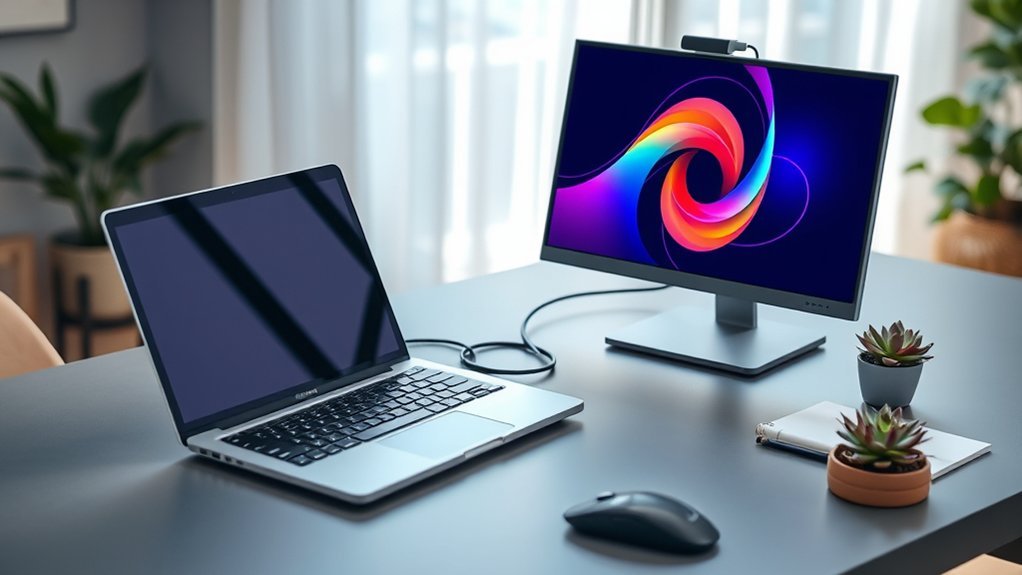Using an external monitor with your laptop is like adding an extra lane to a busy highway—it can greatly improve your workflow. To get started, you’ll need to verify your laptop is compatible with an external display. From understanding ports to adjusting settings, there are several steps involved. Let’s explore how you can easily enhance your workspace and boost your productivity.
Check Your Laptop’s Compatibility
Before you connect an external monitor, it’s essential to check your laptop’s compatibility. Start by identifying the ports on your laptop; common options include HDMI, USB-C, and DisplayPort.
Next, consult your laptop’s user manual or manufacturer’s website to see which external monitors it supports. Some laptops may only work with specific resolutions or refresh rates, so pay attention to those details.
Additionally, check if your laptop’s graphics card can handle the external display; a weak graphics card may limit your experience. By ensuring compatibility, you’ll avoid frustrating issues later on.
Once you’ve confirmed your laptop can support an external monitor, you’ll be ready to enhance your workspace and boost productivity with a larger screen.
Gather the Necessary Cables and Adapters
Once you’ve confirmed your laptop’s compatibility with an external monitor, the next step is to gather the necessary cables and adapters. Depending on your laptop and monitor’s ports, you might need different types of connections. Here’s a quick reference table to help you identify what you need:
| Connector Type | Description |
|---|---|
| HDMI | Standard for most monitors |
| DisplayPort | Common in high-end displays |
| VGA | Older monitors, less common |
| USB-C | Newer laptops, versatile |
| DVI | Used in some older models |
Make sure to check your devices and grab the right cables. Having everything ready will make the connection process smooth and efficient.
Connect the External Monitor
Now that you have all the necessary cables and adapters, you can connect your external monitor to your laptop.
Start by plugging one end of the video cable into the external monitor and the other end into your laptop’s video port. If you’re using an adapter, connect it first to your laptop, then attach the cable.
Make sure both devices are powered on. If your monitor has a power button, press it to turn it on. You might need to select the correct input source on the monitor, so check its settings.
Once connected, your laptop should recognize the external monitor. Enjoy the expanded workspace as you embrace your newfound freedom to multitask and enhance productivity!
Configure Display Settings
After connecting your external monitor, it’s time to configure the display settings to make the most of your expanded workspace.
Start by accessing your display settings through your laptop’s control panel or system preferences.
Here are three key adjustments you can make:
- Resolution: Set the resolution to match your external monitor for ideal clarity.
- Orientation: Choose between landscape or portrait mode based on your tasks.
- Display Arrangement: Drag and drop the monitor icons to position them as they’re physically arranged on your desk.
Once you’ve made these adjustments, click “Apply” to see the changes in action.
This setup allows you to work more efficiently and enjoy the freedom of multitasking across screens.
Optimize Your Workspace
To create an ideal workspace with your external monitor, consider both your physical setup and digital environment.
Begin by positioning your monitor at eye level to reduce strain and enhance comfort. Verify your chair and desk height promote good posture.
Position your monitor at eye level to minimize strain and ensure your chair and desk support good posture.
Next, declutter your physical space; a clean area fosters focus and creativity.
On the digital side, organize your desktop by grouping similar apps or files. Utilize virtual desktops to separate work and personal tasks, giving you more freedom.
Customize your color scheme and fonts to create a pleasant visual experience.
Finally, adjust your lighting to minimize glare and promote a positive atmosphere.
Frequently Asked Questions
Can I Use Multiple External Monitors With My Laptop?
Yes, you can use multiple external monitors with your laptop, as long as your laptop’s graphics card supports it. Just connect the monitors, adjust your display settings, and enjoy an expanded workspace for your productivity!
What Resolution Can My External Monitor Support?
Your external monitor’s resolution depends on its specifications and your laptop’s graphics capabilities. Don’t bite off more than you can chew; check both devices’ limits to guarantee they work together seamlessly for peak performance.
How Do I Switch Back to My Laptop Screen?
To switch back to your laptop screen, press the Windows key + P. Select “PC screen only” from the options. Your display will revert, giving you full control over your laptop’s screen again.
Will Using an External Monitor Drain My Laptop Battery?
Yes, using an external monitor can drain your laptop battery faster. The extra power needed for display output and processing may reduce your battery life, so keep an eye on your power levels while working.
Can I Mirror My Laptop Display on the External Monitor?
Yes, you can mirror your laptop display on the external monitor. Just connect the monitor, then adjust your display settings. Choose the “duplicate” option, and you’ll see your laptop screen mirrored on the external display.
Conclusion
Using an external monitor with your laptop can greatly boost your productivity. In fact, studies show that dual monitors can increase productivity by up to 50%! By following these five easy steps, you’ll not only enhance your workspace but also create a more efficient work environment. So, take the plunge and connect that monitor today—your future self will thank you for the increased focus and improved workflow!

